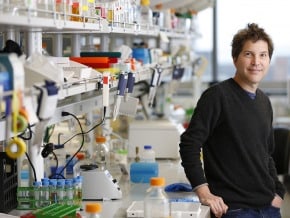
Concluding our brief update on Eric Drexler’s 1981 proposal that de novo protein design provides a path from biotechnology to general capabilities for molecular manipulation, we return to this University of Washington news release “Big moves in protein structure prediction and design”:
In addition to [their recent reports] on modular construction of proteins with repeating motifs [de novo protein design and rational design of protein architectures not found in nature], here are some other recent developments [from the research group of David Baker at the University of Washington Institute for Protein Design]:
Evolution offers clues to shaping proteins: The function of many proteins tends to stay the same across species, even after their amino acid sequences have changed over billions of years of evolution. Locating co-evolved pairs of amino acids helps calculate their proximity when the molecule folds. UW graduate student Sergey Ovchinnikov applied this co-evolution DNA sequence analysis in an E-Life paper published Sept. 3, 2015, “Large-scale determination of previously unsolved protein structures using evolutionary information.” [Open Access] The effort illuminated for the first time the structures of 58 families of proteins that have hundreds of thousands of additional, structurally related family members.
“This achievement was a grand slam home run in the history of protein structure prediction,” said Baker.
Barrel-fold design: Baker lab postdoctoral fellow Po-Ssu Huang, together with Birte Höcker at the Max Planck Institute for Developmental Biology in Germany discovered the elusive design principles for a barrel-shaped fold underpinning many natural enzyme molecules. The custom designed barrels folds, built at the IPD, were presented Nov. 23, 2015, in the Nature Chemical Biology paper, “De novo design of a four-fold symmetric TIM-barrel protein with atomic-level accuracy.” [abstract, full text PDF courtesy of the Baker lab] This achievement has opened the door for bioengineers to generate totally new enzymes that speed up chemical reactions by positioning smaller molecules in custom barrel compartments.
Self-assembling apparatus: Ordered protein arrays along a flat plane are found in bacteria, the heart, and other muscles. Overcoming protein interaction complexities, researchers at the IPD and the Janelia Research Campus of the Howard Hughes Medical Institute programmed proteins to self-assemble into novel symmetric, 2-dimensional sheets of protein lattice patterns. UW graduate student Shane Gonen in the Baker lab, with his brother Tamir Gonen at Janelia, described their work in the June 19, 2015, issue of Science, “Design of ordered two-dimensional arrays mediated by non-covalent protein-protein interfaces.” [abstract, full text PDF courtesy of the Baker lab] This research has applications for self-assembling protein nanomaterials, especially efficient sensors or light harvesters.
Precision sculpting: Protein designers are continuously refining principles for fashioning ideal protein structures. A paper in the Oct. 6, 2015, Proceedings of the National Academy of Sciences, “Control over overall shape and size in de novo designed proteins,” further explains methods for systematically varying protein architecture inspired by nature. Such finesse could optimize designed proteins to take on the proper shapes for the desired functions. This work was led by Baker lab graduate student Yu-Ru Lin in collaboration with Nobuyasu Koga at the Institute for Molecular Science in Japan.
Each of the advances reported in the above papers is noteworthy in itself, but what seems especially exciting is that multiple advances in de novo protein design have occurred in such a short time in one place. Other significant advances related to the ones covered above and in the two previous posts can be seen in the titles of the papers listed on the Baker Lab publications page. This technology is clearly being developed to pursue an array of goals covering a number of time frames, but this progress also gives hope that momentum may be building along the de novo protein design path to atomically precise manufacturing.
—James Lewis, PhD

